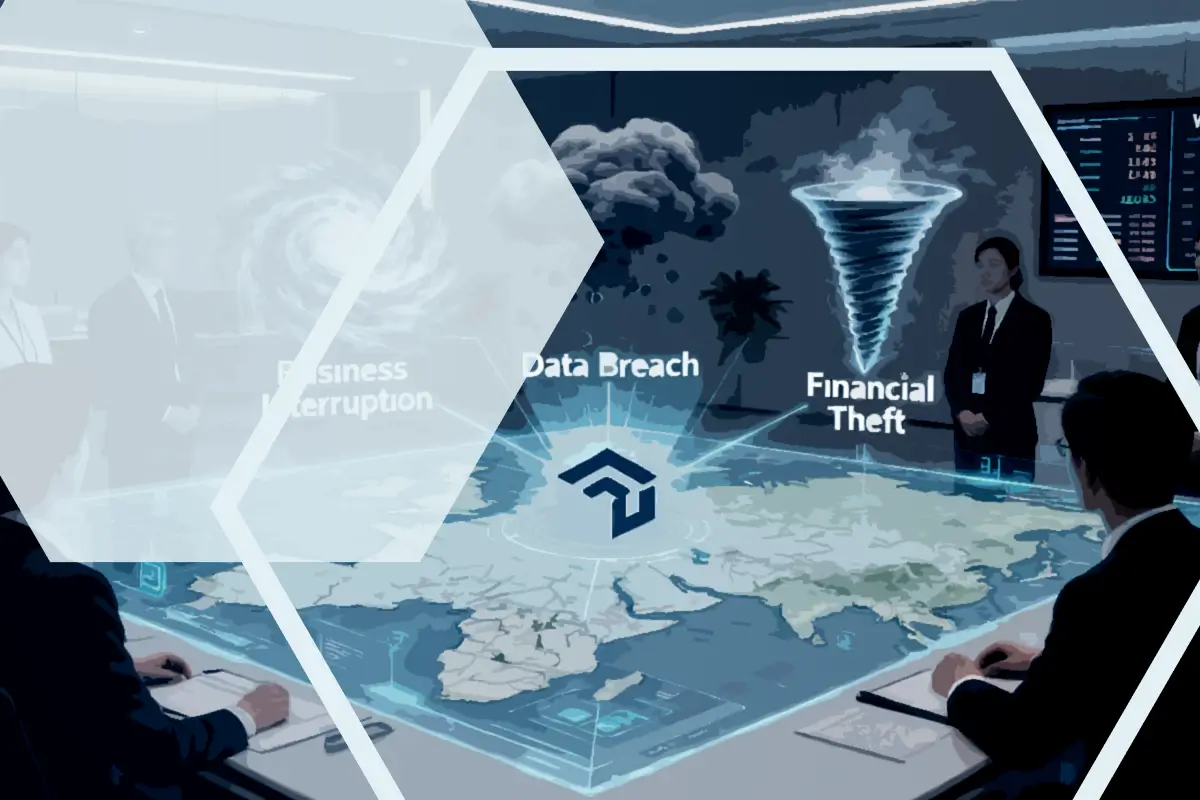Crowdstrike, NotPetya, Wannacry: it is the catastrophic cyber events that show up on the news and catch the attention of senior executives and the Board. However, cybersecurity teams in companies around the world successfully handle smaller incidents every day; managing these routine but low impact events is important but there are no headlines for the day-to-day. Being able to plan for, detect, and respond to incidents large and small is a core capability of cybersecurity; doing it well will keep your company out of the headlines.
Cyber crises, the high impact but low probability events, will have significant financial and business implications and could lead to negative headlines if not properly managed. Understanding what the worst case scenarios are for your organization enables you to identify the cost drivers, and also the necessary protection and recovery goals.
Cyber Risk Quantification can support this planning and gives the Board financial metrics to put such risks in the context of the wider risks the enterprise faces, and gives the CISO the inputs needed for a business case for improvement.
This article explores how to effectively plan for, assess, and mitigate a cyber crisis using Cyber Risk Quantification. By the end of this article, you will have a deeper understanding of how to create resilient cybersecurity strategies using the Squalify CRQ platform.
Key Takeaways
- A cyber crisis is an unpredictable, low-probability, high-impact event with significant financial implications. Cyber crisis management requires a strategic approach across the organization and is of interest to Top Management and at Board level.
- Routine cyber incidents by contrast are those that are more predictable, and can be managed using regular day-to-day incident management processes. Because these incidents have a low impact on the business they do not usually need attention from the Board.
- Cyber crisis management and cyber risk quantification share common activities. Squalify’s Top-down Cyber Risk Quantification (CRQ) approach focuses on crisis scenarios, and attaches a monetary value to these, enabling the upper management and the board to prioritize cyber risk mitigation strategies based on potential business financial impacts.
Cyber Crisis vs. Routine Cyber Incidents
Understanding the difference between a cyber crisis and a routine cyber incident is critical because it has profound implications for your risk management and strategic planning. Both types of event have different frequency and severity, resulting in different exposure and damage patterns.
Cyber Crisis
A cyber crisis is a large scale event caused by a cyber threat that leads to significant and long term impact to an organization. A cyber crisis will have a relatively low probability of occurrence (hopefully!) and it is likely to be unpredictable. Understanding the nature and impact of such a crisis event is necessary to effectively manage these risks.
For example, a significant breach of personal data could lead to a cyber crisis. In this case, costs can quickly add up. In addition to incident response, recovery, and forensics costs there may be long term costs for customer credit monitoring, litigation costs to defend against lawsuits, substantial regulatory fines, loss of business as well as more intangible costs arising from loss of customer trust and long-term damage to the company’s reputation.
A cyber crisis will by definition have a significant and potentially existential impact on the organization. Crisis management requires a more strategic response than routine incident management and can take into account alternative risk management approaches such as cyber insurance risk transfer, and considering whether the company should pay a ransomware demand (which may have legal and regulatory considerations).
In order for the Board to perform its governance and risk oversight functions it is important that the consequences and management approaches to potential cyber crises are reported in understandable non-technical language. Quantifying the impact of cyber crisis scenarios using tools such as Cyber Risk Quantification (CRQ) is effective for evaluating potential risk and crisis scenarios over time. The goal is to properly prioritize these low-probability, high-severity events according to your organization's risk appetite to mitigate unforeseen, catastrophic consequences.
Routine Cyber Incidents
Routine incidents by contrast are those that can be managed using regular day-to-day incident management processes. These incidents will happen relatively often (perhaps multiple times per year) and have minimal impact on a company’s operations. While the timing of exactly when these incidents occur may be unpredictable, the impacts are usually easy to understand and predict and as such incident response plans or “runbooks” can be prepared to handle them consistently.
Because these incidents have a low impact on the business they do not usually need attention from the Board. It is for this reason that Squalify focuses on crisis scale scenarios.
How Cyber Risk Quantification Can Help Effectively with Cyber Crisis Management
Successfully preparing for cyber crisis management and preparing an effective cyber risk quantification share a number of common activities:
- the predictable parts of a crisis can be quantified: the information needed to prepare for a crisis and a risk quantification will come from similar sources. Obtaining a clear view of the stakeholders involved, for example legal, communications, cyber insurance, not only helps with planning a crisis response but also identifies stakeholders who can help with identifying the associated costs and financial considerations for inclusion in a risk quantification model.
- prioritizing risks at the enterprise level: quantifying the potential impacts from multiple crisis scenarios enables an organization understand and compare their aggregated risk exposure, and hence prioritize where best to make investments to manage the most critical risks.
- CRQ can be used to test, validate, and develop crisis plans: cyber risk quantification should prompt organizations to reflect on their incident and crisis preparedness. The inputs and outputs from CRQ can be used to test crisis planning assumptions and see the impacts of changing key parameters. For example, using the Squalify platform you can quickly model the difference in financial impact should 100 million vs one billion personal data records be breached, or test the impact of different durations of business interruption. This sensitivity testing can be used to set recovery targets and thresholds with confidence that these targets are backed by the data of potential financial losses. This also helps conversations with the board, for example: “we’re confident that if the crisis lasts 10 days the potential losses are $Xmillion dollars, but if it lasts 30 days it could cost up to $Ymillion dollars.”
Squalify’s top-down approach to cyber risk quantification excels at providing you with an aggregated view of your enterprise-wide cyber risk in financial metrics. We have a built-in set of prompts for business interruption, personal data breach, and financial theft and fraud scenarios, to help you quickly obtain the right information and so you can address the most critical risks based on their economic impact with data-driven evidence. With the Squalify platform, you can even benchmark the performance and demonstrate the ROI of these risk mitigation activities to your board of directors.
How Squalify Empowers Organizations to Assess and Manage Cyber Crises
The Squalify platform serves for managing long-term resilience and decision-making. By employing a top-down methodology for cyber risk quantification, Squalify supports strategic cyber risk management at the upper levels of the organization.
Quantify the impact of cyber crises with Squalify
Squalify makes it simple to asses the financial impact of a cyber crisis:
- Worst-Case Scenarios: Squalify begins with a "worst-case" assessment to quickly calculate an upper loss limit based on easily and quickly obtained information such as the organization’s revenue, industry and number of employees. Using our built-in benchmarking dataset we provide a first estimate within minutes.
- Prompts for common cyber crisis scenarios: we have a built-in library of questions to help you obtain the necessary information to model business interruption, personal data breach, and financial theft and fraud scenarios. Completing these scenario-specific questions contextualizes the worst-case scenario to your organization and provides the necessary inputs for the statistical quantification of the losses.
- Value at Risk (VaR) Calculation: combining the scenario-specific inputs with your enterprise security maturity, Squalify then statistically calculates a number of financial metrics. The Value at Risk (VaR) or Modeled Large Loss, estimates the financial loss your organization could experience under high-impact but less extreme scenarios than Worst Case Loss. This metric helps you understand the financial impact of significant, but plausible, cyber events that could severely disrupt your operations. Squalify calculates the Value at Risk for recurrence intervals of 1 in 100 years, 200 years, 500 years, and 1,000 years, corresponding to probabilities of occurrence of 1%, 0.5%, 0.2%, and 0.1% respectively.
Planning for and Mitigating Cyber Crises with Squalify
After assessing the potential financial impact of cyber crisis scenarios you can use the Squalify platform to take strategic action towards mitigating these catastrophic event.
Identify areas for information security investment
Squalify’s Risk Balance feature helps you assess whether your organization's information security maturity is balanced with its inherent cyber risk. You can visualize the most vulnerable areas for security investment. The Risk Balance can also be a useful metric for discussing risk appetite, and identifying which scenarios would most benefit from further investment.
Strategic controls improvements
Once you have identified areas for security investment, Squalify enables you to quickly identify the key security controls that will have the greatest impact on improving your organization's cyber risk posture. Tailored to your unique risk landscape, these controls provide a strategic foundation for effective cybersecurity improvements, especially for organizations with limited resources.
Simulate the effectiveness and ROI of strategic remediation programs
Squalify’s simulations feature allow you to assess how planned changes to your security controls impact your overall cyber risk. By simulating information security control improvements in the Squalify platform, you can immediately see how control improvements reduce the financial exposure and use this to strategically prioritize investments to achieve the greatest reduction in financial risk. At the same time, you can visualize the impact of the simulation on your organization's risk profile in the Risk Balance and validate the ROI of your cybersecurity strategies before implementation.
Cyber insurance planning
Having a clear understanding of the potential financial losses from a cyber crisis scenario gives your organization important information to inform decision making for cyber insurance. For example, knowing the potential worst case loss and the Value at Risk can enable you to decide appropriate coverage limits and deductibles. Understanding your current state of crisis readiness can also help you negotiate relevant services from the insurer, such as support for forensics, threat intelligence, or public relations management during a crisis.
Frequently Asked Questions about Cyber Risk Mitigation Strategies
What is a cyber crisis, and why are they significant for businesses?
A cyber crisis is an unpredictable, low-probability, high-impact event that can cause substantial financial and reputational damage to organizations. Despite their rarity, these events can severely disrupt operations and jeopardize a company’s financial health, making it crucial for business leaders to incorporate them into their risk management strategies.
How does Cyber Risk Quantification (CRQ) help in assessing cyber crises?
CRQ attaches a monetary value to cyber risks, providing organizations with a clear understanding of the financial impact of potential cyber crises. By focusing on high-severity events, CRQ enables decision-makers to prioritize risk mitigation strategies based on their economic impact and the organization's risk appetite.
What’s the difference between a cyber crisis and a routine cyber incident?
A cyber crisis is a large scale event caused by a cyber threat that leads to significant and long term impact to an organization. A cyber crisis will have a relatively low probability of occurrence (hopefully!) and it is likely to be unpredictable. Cyber crisis management requires a strategic approach across the organization. Routine cyber incidents by contrast are those that can be managed using regular day-to-day incident management processes. These incidents will happen relatively often (multiple times per year) and have minimal impact on a company’s operations.
How does Squalify help mitigate the impact of a cyber crisis?
Squalify quantifies the financial impact of cyber crisis scenarios through tools such as Worst-Case Loss assessment, scenario modelling, quantifying the Value at Risk, providing insight into high severity scenarios. The Squalify platform provides prompts for common crisis scenarios such as Business Interruption, Personal Data Breach and Financial Theft and Fraud, facilitating data gathering and modeling. It provides insight into your information security maturity and risk exposure, identifying areas for strategic investment. We can also automatically identify the top controls to invest in, based on your organization's maturity and cyber risk. Finally, simulations validate the impact and ROI of strategic improvement programs, helping you prioritize investments.
Why is an aggregated view of cyber risk important for managing cyber crises?
An aggregated view of cyber risk enables organizations to see the full spectrum of potential threats across the enterprise. This holistic perspective helps prioritize high-severity risks and ensures resources are allocated effectively to protect critical assets and operations from potentially catastrophic cyber events.
Final Words
To maintain financial stability and resilience, organizations must understand and address their most critical cyber risks. A cyber crisis event may have a low probability of occurring, but they can have a significant financial impact that threatens an organization's operations and growth.
Cyber Risk Quantification (CRQ) helps assess and mitigate the impact of cyber crises. A risk-based approach that leverages an aggregated view of risk at the enterprise level ensures a holistic view of risk across the enterprise, rather than an isolated focus on assets.
The Squalify platform effectively assesses cyber crisis scenarios by providing data-driven insights into the potential financial impact and likelihood of catastrophic loss. Our insights support risk mitigation activities by providing information about your organization's risk posture and most vulnerable areas, along with targeted security investment recommendations. This integrated approach helps you understand the true cost of cyber incidents and support critical cybersecurity efforts.









